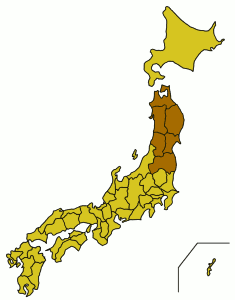Tohoku region
|
|
Tetsubin1571.jpg
The Tohoku region (東北地方; Tōhoku-chihō) is a geographical area of Japan. Tōhoku is Japanese for "northeast," and the Tohoku region occupies the northeastern portion of Honshu, the largest island of Japan. The area is also known as Michinoku (みちのく).
The region consists of six prefectures: Akita, Aomori, Fukushima, Iwate, Miyagi and Yamagata Prefectures.
The last stronghold of the indigenous Ainu on Honshu and the site of many battles, Tohoku retains a reputation as a remote and backward region, offering breathtaking scenery but a harsh climate. Tohoku is immemorialized in haiku poet Matsuo Basho's work Oku no Hosomichi (The Narrow Road to the Deep North).
Tohoku, like most of Japan, is hilly or mountainous. Its initial historical settlement occurred between the seventh and ninth centuries A.D., well after Japanese civilization and culture had become firmly established in central and southwestern Japan. Although iron, steel, cement, chemical, pulp, and petroleum-refining industries began developing in the 1960s, Tohoku was traditionally considered the granary of Japan because it supplied Sendai and the Tokyo-Yokohama market with rice and other farm commodities. Tohoku provided 20 percent of the nation's rice crop. The climate, however, is harsher than in other parts of Honshu and permits only one crop a year on paddy land.
The inland location of many of the region's lowlands has led to a concentration of much of the population there. Coupled with coastlines that do not favor port development, this settlement pattern resulted in a much greater than usual dependence on land and railroad transportation. Low points in the central mountain range fortunately make communications between lowlands on either side of the range moderately easy. Tourism became a major industry in the Tohoku region, with points of interest including:
- Hirosaki
- the islands of Matsushima Bay
- Lake Towada
- Oirase River Valley
- Lake Tazawa
- Kakunodate
- the Rikuchu Coastline National Park
- the Bandai-Asahi National Park
- Sanriku Coastline
- Morioka
- Hiraizumi
- Aizu
- Mt. Bandai
- Three Mountains of Dewa
See also
External links
References
- Template:Loc - Japan (http://lcweb2.loc.gov/frd/cs/jptoc.html)
| edit (http://en.wikipedia.org/w/wiki.phtml?title=Template:Japan&action=edit) | Prefectures of Japan | Missing image Japan_flag_large.png Flag of Japan |
|---|---|---|
| Aichi | Akita | Aomori | Chiba | Ehime | Fukui | Fukuoka | Fukushima | Gifu | Gunma | Hiroshima | Hokkaido | Hyogo | Ibaraki | Ishikawa | Iwate | Kagawa | Kagoshima | Kanagawa | Kochi | Kumamoto | Kyoto | Mie | Miyagi | Miyazaki | Nagano | Nagasaki | Nara | Niigata | Oita | Okayama | Okinawa | Osaka | Saga | Saitama | Shiga | Shimane | Shizuoka | Tochigi | Tokushima | Tokyo | Tottori | Toyama | Wakayama | Yamagata | Yamaguchi | Yamanashi | ||
| Regions of Japan | ||
| Hokkaido | Tohoku | Kanto | Chubu (Hokuriku - Koshinetsu - Tokai) | Kansai | Chugoku | Shikoku | Kyushu | ||
| Major Cities | ||
| 23 wards of Tokyo | Chiba | Fukuoka | Hiroshima | Kawasaki | Kitakyushu | Kobe | Kyoto | Nagoya | Osaka | Saitama | Sapporo | Sendai | Shizuoka | Yokohama | ||
de:Tōhoku es:Región de Tōhoku ko:도호쿠 지방 ka:ტოჰოკუ ja:東北地方 pt:Tohoku sv:Tohoku zh:东北地方

